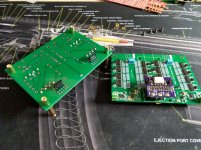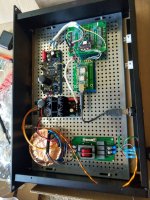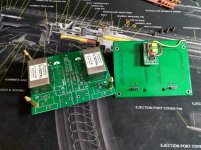Tio: To be sure, by no means am I trying to dampen anyone's enthusiasm for trying the ultra cap power approach, and I am glad you are reporting your findings, I will probably try them in some fashion myself at some point, as I am curious. I would like to see someone with a spectrum analyzer do some noise measurements of ultra caps under load to see what their noise signature is really like, and to answer the technical question as to whether they have less noise, or more, than well sorted regulated style power supplies. As long as the voltage remains steady (short term) then as Vit suggests there should be no non-linearity problem with the DSC style DACs. Although declining voltage as they discharge, and the associated declining output level of the DAC would be disturbing to me: how well do ultra caps hold their voltage through the discharge cycle?
Thinking of output Z as a single number could be misleading, I would think that the Z at the operating frequency of the shift registers would be the relevant concern, but the LC filtering on the DSC-2.x will change that. I would like to know what aspect of the ultra caps performance is responsible for the performance you hear with your DSC-1, the noise profile, or the output impedance: I guess this would require some precise measurements to know just what one is working with, does anyone know of any members capable of such measurements working with ultra caps?
I believe what's needed is a differential measurement of dynamic noise profile under dynamic load not just the noise measurement at fixed frequencies usually given for voltage regulators
+1
I'm not a guru in electronics, rather an enthusiast.
Several times I've discussed power supply for DSC2 with Pavel. His opinion - built-in in LDO ADP7118 (2.5.2 / 2.6.2) with a futher filtering on the DSC board is a very good approach.
I've experimented with his older DSC2.5 version (LT3042, LT3045, TPS7A4700, Salas Reflector D) w/o any substantial improvements (IMO).
Honestly I am very interested in your approach. I'll try.
1. Connecting ultracaps to DSC2 directly (built in LDO disabled)
2. Connecting ultracaps to DSC2 with some resistor in series to increase impedance up (built in LDO disabled).
Built in LDO on DSC 2.5.2/2.6.2 can be disabled easily by shorting two jumpers.
I think no substantial improvements might be because of couple of reasons:
1. All those regs are based on some better/worse current feedback design
2. Overal perfromance might be dominated by LC filter on DSC2
3. In audio all counts and final perferomance depands on the whole audio chain. The system is as good as it worst part.
Tio: To be sure, by no means am I trying to dampen anyone's enthusiasm for trying the ultra cap power approach, and I am glad you are reporting your findings, I will probably try them in some fashion myself at some point, as I am curious. I would like to see someone with a spectrum analyzer do some noise measurements of ultra caps under load to see what their noise signature is really like, and to answer the technical question as to whether they have less noise, or more, than well sorted regulated style power supplies. As long as the voltage remains steady (short term) then as Vit suggests there should be no non-linearity problem with the DSC style DACs. Although declining voltage as they discharge, and the associated declining output level of the DAC would be disturbing to me: how well do ultra caps hold their voltage through the discharge cycle?
Thinking of output Z as a single number could be misleading, I would think that the Z at the operating frequency of the shift registers would be the relevant concern, but the LC filtering on the DSC-2.x will change that. I would like to know what aspect of the ultra caps performance is responsible for the performance you hear with your DSC-1, the noise profile, or the output impedance: I guess this would require some precise measurements to know just what one is working with, does anyone know of any members capable of such measurements working with ultra caps?
Sure thing. All you say is a valid point. I am also curious about measurements.
Got mine "running" at least according to the scope.
Some modifications here:
5v to 3.3v regulator on the DSC2 board.
Mount the 3pin headers so I can stack the board and detach DAC board and output board.
Using Cronus to reclock inputs from Amanero. They are connected via u.fl cables through a header I made.
Mute pin is taken directly from Amanero but isolated by a TLP222A.
DSDON is not connected.
To-do:
Manage heat from Reflector-D. the 1.5Ohm resistor is getting to hot to run long.
Finish output board.
Some modifications here:
5v to 3.3v regulator on the DSC2 board.
Mount the 3pin headers so I can stack the board and detach DAC board and output board.
Using Cronus to reclock inputs from Amanero. They are connected via u.fl cables through a header I made.
Mute pin is taken directly from Amanero but isolated by a TLP222A.
DSDON is not connected.
To-do:
Manage heat from Reflector-D. the 1.5Ohm resistor is getting to hot to run long.
Finish output board.
Attachments
How are you going to cope with the cooling? Big radiator?To-do:
Manage heat from Reflector-D. the 1.5Ohm resistor is getting to hot to run long.
I've tried active cooling with one 12cm Noctua fan and got stable 38 - 40 C (3 Reflector D, 2Ohm, 2Ohm, 1Ohm). But there were small chasis vibrations that I did not like.
There are two Reflector-Ds in the picture. One is supplying cronus with 1.5Ohm resistor. Another is supplying both channel of DSC with 1Ohm.How are you going to cope with the cooling? Big radiator?
I've tried active cooling with one 12cm Noctua fan and got stable 38 - 40 C (3 Reflector D, 2Ohm, 2Ohm, 1Ohm). But there were small chasis vibrations that I did not like.
Right now I'm measuring 1.9v across the 1.5Ohm resistor. That's about 2.5W I need to get rid of. Not a big deal, I can connect it to the base plate like what I did for the 1Ohm one.
For the 1Ohm one, transistors are getting too hot too. So they are mounted on the base plate. For the 1.5Ohm one it's not that bad. They will stay with on board heatsink.
Last edited:
u.fl adapters...
Hi, are your u.fl adapters for Cronus, etc, available from Oshpark? I would be interested.
Got mine "running" at least according to the scope.
Some modifications here:
5v to 3.3v regulator on the DSC2 board.
Mount the 3pin headers so I can stack the board and detach DAC board and output board.
Using Cronus to reclock inputs from Amanero. They are connected via u.fl cables through a header I made.
Mute pin is taken directly from Amanero but isolated by a TLP222A.
DSDON is not connected.
To-do:
Manage heat from Reflector-D. the 1.5Ohm resistor is getting to hot to run long.
Finish output board.
Hi, are your u.fl adapters for Cronus, etc, available from Oshpark? I would be interested.
I'd say it's more for DSC.Hi, are your u.fl adapters for Cronus, etc, available from Oshpark? I would be interested.
It exposes D1,D2 and CLK. Use TLP222A to isolate DSD_ON and MUTE.
I did some tweaks after the first version. I will publish and share the new one later on here and via oshpark.
Yes,
Understood, and thanks!
I'd say it's more for DSC.
It exposes D1,D2 and CLK. Use TLP222A to isolate DSD_ON and MUTE.
I did some tweaks after the first version. I will publish and share the new one later on here and via oshpark.
Understood, and thanks!
Has anyone ever tried building a DSC-1/2 using super high quality resistors? Say Z-foil? I see Denafrips appears to use .005% thin films on their top model, and there are claims as to sound quality benefits. As the signal is basically analog at this point, i would think resistor sound quality would matter.
Just thinking out loud here and wondering. I know somewhere on this thread I did see some measurements which appeared to show higher precision resistors giving better measured performance... Thoughts?
Just thinking out loud here and wondering. I know somewhere on this thread I did see some measurements which appeared to show higher precision resistors giving better measured performance... Thoughts?
High precision resistors are required in the DAC R2R type.i would think resistor sound quality would matter.
Just thinking out loud here and wondering. I know somewhere on this thread I did see some measurements which appeared to show higher precision resistors giving better measured performance... Thoughts?
DSC uses the Rectangular Window FIR Filters. Therefore, there is no need for very high precision resistors.
According to my measurements, there is no difference between 1% and 0.1% resistors.
Last edited:
How are you going to cope with the cooling? Big radiator?
I've tried active cooling with one 12cm Noctua fan and got stable 38 - 40 C (3 Reflector D, 2Ohm, 2Ohm, 1Ohm). But there were small chasis vibrations that I did not like.
How do you handle grounding among your PSUs? I'm guessing you are using 1 Reflector-D per channel and 1 for the digital source?
Yes...
Pavel, I am aware that super precision resistors are not required for DSC-1 technical performance vs. PCM/R2R DACs... I am curious though as to subjective sound quality. At some point someone will build a DSC style DAC and use Z-foils just to see what the sound quality might be.
Just curious...
High precision resistors are required in the DAC R2R type.
DSC uses the Rectangular Window FIR Filters. Therefore, there is no need for very high precision resistors.
According to my measurements, there is no difference between 1% and 0.1% resistors.
Pavel, I am aware that super precision resistors are not required for DSC-1 technical performance vs. PCM/R2R DACs... I am curious though as to subjective sound quality. At some point someone will build a DSC style DAC and use Z-foils just to see what the sound quality might be.
Just curious...
How do you handle grounding among your PSUs? I'm guessing you are using 1 Reflector-D per channel and 1 for the digital source?
I'am using Reflector D for another DAC (Soekris dam1121 - Left, Right output line power, Didital line power), not for DSC. Reflector's earth connected to dam1121 earth. All of them are placed on nylon spacers.
But I have 50Hz harmonics with Reflector and can't eliminate them (have look at http://www.diyaudio.com/forums/power-supplies/261031-reflektor-builds-122.html#post5146329)
I'am using Reflector D for another DAC (Soekris dam1121 - Left, Right output line power, Didital line power), not for DSC. Reflector's earth connected to dam1121 earth. All of them are placed on nylon spacers.
But I have 50Hz harmonics with Reflector and can't eliminate them (have look at http://www.diyaudio.com/forums/power-supplies/261031-reflektor-builds-122.html#post5146329)
I think I too have it: Imgur: The magic of the Internet
This is a plot from years ago with DSC1 with Reflector-D, although it's far superior than LM1086: Stock DSC1 - Imgur
I remember when I was supplying Reflector-D with a bench top PSU I no longer have noise from AC lines. When my DSC2 is running and stable, I will see if the same applies for DSC2.
Question about I2S ingress sharing ...
How difficult it is the creation of shared Y shaped I2S circuit? I mean having the DSC2.x ingress drived by two different I2S boards automatically or manually selected. One side of Y will be Amanero, the other one another I2S board
You would need MUX for that. E.g.: something like this:
OTTO-II 2:1 Switching Module
or this module:
????I2S/IIS?????????I2S?????2??1-???
Yep. I have this one. It worked for me. However the one from twisteadPearAudio have space for u.fl connectors, if one should need that.
Yep. I have this one. It worked for me. However the one from twisteadPearAudio have space for u.fl connectors, if one should need that.
Wow ... thanks both for quick comments!
- Home
- Source & Line
- Digital Line Level
- Signalyst DSC1


